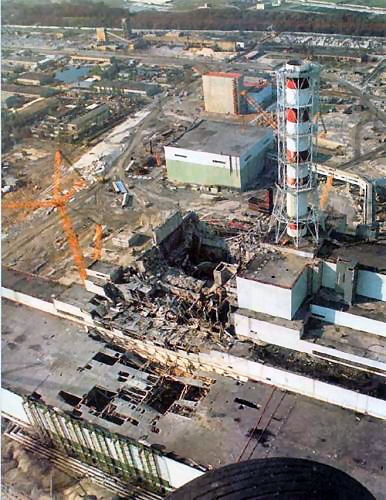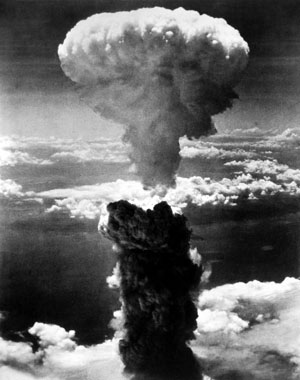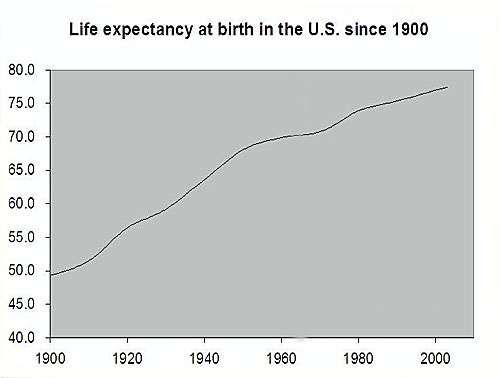Well, I cannot cover all the major technological innovations of the past half century in any semblance of depth. So I will focus on four, but first I'd like to point out that World War II provided a major spurt for technological progress that carried through into the postwar period: jet airplanes, rockets. radar, the computer, antibiotics like penicillum.
- atomic energy (It is easy to see how this, in the form of nuclear weaponry, became a major component of the Cold War.)
- Medicine
- Electronics, since innovations in this fields have been one of the driving forces of the consumer revolution and pop culture
- Computers

Atomic Energy
How about an image of th emelted containement dome or the shroud fro ChernobylThen another image of a thermonuclear explosion

http://www.atomicarchive.com/History/coldwar/images/chernobyl.jpg
show an atom bomb and hyrdopgen bomb explosoion
Hydrogen bomb or H-bomb, derives a large portion of its energy from the nuclear fusion of hydrogen isotopes. In an atomic bomb, uranium or plutonium is split into lighter elements that together weigh less than the original atoms, the remainder of the mass appearing as energy. Unlike this fission bomb, the hydrogen bomb functions by the fusion, or joining together, of lighter elements into heavier elements. The end product again weighs less than its components, the difference once more appearing as energy. Because extremely high temperatures are required in order to initiate fusion reactions, the hydrogen bomb is also known as a thermonuclear bomb.
The first thermonuclear bomb was exploded in 1952 at Enewetak by the United States, the
second in 1953 by Russia (then the USSR). Great Britain, France, and China have also exploded thermonuclear
bombs, and these five nations comprise the so-called nuclear club-nations that have the capability to produce
nuclear weapons and admit to maintaining an inventory of them. The three smaller Soviet successor states
that inherited nuclear arsenals (Ukraine, Kazakhstan, and Belarus) relinquished all nuclear warheads, which
have been removed to Russia. Several other nations either have tested thermonuclear devices or claim to
have the capability to produce them, but officially state that they do not maintain a stockpile of such
weapons; among these are India, Israel, and Pakistan. South Africa's apartheid regime built six nuclear
bombs but dismantled them later.
Since the fusion reaction produces mostly neutrons and very little that is radioactive,
the concept of a "clean" bomb has resulted: one having a small atomic trigger, a less fissionable
tamper, and therefore less radioactive fallout.
http://www.cfo.doe.gov/me70/manhattan/early_bomb_design.htm
A dense column of smoke rises more than 60,000 feet into the air over the Japanese port of Nagasaki, the result of an atomic bomb, the second ever used in warfare, dropped on the industrial center August 8, 1945, from a U.S. B-29 Superfortress. (OWI) NARA FILE #: 208-N-43888 WAR & CONFLICT BOOK #: 1242 (Released to Public) | ||||||
|
|
||||||
|
|
Date Shot: 8 Aug 1945 |

Source US DOD http://www.defenselink.mil/multimedia/
On the 26th of March 1964 this H-bomb test, Castle Romeo, was one of the biggest ever.
The first H-bomb ever 'Mike' was exploded at 7.15 am local time on November 1st 1952. The mushroom cloud was 8 miles across and 27 miles high. The canopy was 100 miles wide. Radioactive mud fell out of the sky followed by heavy rain. 80 million tons of earth was vaporised. Mike was the first ever megaton yeild explosion.
Castle Bravo was the biggest bomb ever detonated by Western Powers. This
lithium-deuteride fuelled H-bomb test exploded 1st March 1954 at Bikini Atoll.
It yielded 15 megatons and had a fireball 4 miles in diameter. It was much
bigger than the test crews had been expecting. It engulfed its 7,500 foot
diagnostic pipe array all the way out to the earth-banked instrument bunker,
which barely survived. Test crews were trapped in experiment bunkers well
outside the expected limits of its effects. It menaced task force ships,
one of which held Marshall Rosenbluth, a U.S. theoretical physicist, "I was
on a ship that was thirty miles away, and we had this horrible white stuff
raining down on us. I got 10 rads [100 chest x-rays] of radiation from it.
It was pretty frightening. There was a huge fireball with these turbulent
rolls going in and out. The thing was glowing. It looked to me like a diseased
brain up in the sky. It spread until the edge of it looked as if it was almost
directly overhead. It was a much more awesome sight than a puny little atomic
bomb. It was a pretty sobering and shattering experience." Bravo vaporised
a crater 250' deep and 6,500' in diameter out of the atoll rock. The 'horrible
white stuff' was calcium precipitated from vaporised coral.
http://www.bilderberg.org/hbomb.htm#tests

B. Albert Einstein, 1879-1955
1. Life
a. Born in Ulm, family electric machinery shop, later they moved to Milan
b. after graduation went to work for Swiss National Patent office
c. three major 1905 papers
d. 1916, general relativity
e. 1932 emigrated to US, had been at Berlin int of physics, but he was jewish
f. Advanced study at Princeton
2. Ideas
a. revised Newtonian physics
b. became a kind of symbol of the loftiness of science
c. as a result of some experiments of american scientists to find the "ether," that propagated light waves
d. in 1905, he formulated his first, or special, theory of relativity
1) asserted that speed of light is a constant, a law of nature,
2) all measurements of space and time are relative to speed of light which is a constant, later made it general to all inertial frames of reference
e. the second, or general, came in 1915 with the theory of relativity
1) *****space and time are not absolute quantities, but relative to the observer, and may be considered as aspects of a single continuum
2) time is a fourth dimension linked to space
3) tremendous power of E=mc2
f. 1921, Nobel Prize
g. fled to US in 1933, to Princeton
h. 1939, backed the set up of the Manhattan project (wrote letter to FDR), because Germans had stumbled upon the "chain reaction," which via Einstein's formula promised to unleash much power
3. Einstein and Peace
a. after the war, Einstein became deeply involved in a search for peace, a World government that could intervene
b. part of this came out of moral concern over use of the bomb
1) scientists were straight-away faced with moral dilemmas of their work and its destructive impact on humanity's fate
c. Einstein had not wanted it to be used vs Japan
1) he had supported the project so that enemies did not get it first
2) advocated a World Government of the Big 3 to control the bomb, constitution written by 3 people, able to intervene wherever a majority was oppressing a minority
3) threat of war had not changes, but destructive potential had changed
4. also experiments of atom and knowledge of its composition
a. 1902, german physicist, Max Planck, 1858-1947, and the "quantum theory" of energy
1) a constant number
2) energy is not analog
5. but still difficulties with trying to figure out the nature of light, and in 1920s the german physicist Werner Heisenberg argued uncertainty
a. *****that no fixed model of an atom was possible, only its approximate structure could be arrived at*****
b. Since atom was mostly space and very small, it was impossible to measure simultaneously both the energy and mass of a subatomic particle (measurement of one affected the other)
c. *****thus in sub-atomic world also as in Einstein's macro world, observer made it all relative****
6. there were no longer any reassuring absolutes
a. this really made scientist humbler in philosophical terms.

Medicine
Well, you could question whether medicine beloigns in these remarks with technology, bu tI think it does as certinaly both pure science and the applicaiton of technology have readically chnages the health professions in the past fifty years.For example, look at all the vaccines that a child now gets so that they will never have to deal with certain diseases.
Look at the kinds of treaments now available.
If you had cancer in 1953 as Aleksandr Solchenitsyn, surgery was your options.
If you had a heart condition, the docotro might prescribe you a sup of warm tea.
Before the 1940s, if you have an infection, the doctor could try and cauterize the wound, cut off the infeced appendage, or you could die.

I have seen many versions of this chart, so why I am not absolutely sure of the exactness of this data, but you can still get a get a gneral lidea of what has happened.
Tru, part of the increase in expectancy is duo to etter food.
http://divisionoflabour.com/archives/life%20expectancy.JPG
Not even mentioning the flu vaccine an annula
Vaccines
Source:
http://familydoctor.org/online/famdocen/home/healthy/vaccines/028.html
The DTaP vaccine is 3 vaccines in 1 shot. It protects against diphtheria, tetanus and pertussis. It's given as a series of 5 shots. The Td vaccine is used as a booster to the DTaP vaccine. It helps prevent tetanus and diphtheria. It's given when your child is 11 years old or older and every 10 years throughout life.
Diphtheria is a disease that attacks the throat and heart. It can lead to heart failure and death. Tetanus is also called "lockjaw." It can lead to severe muscle spasms and death.
Pertussis (also called "whooping cough") causes severe coughing that makes it hard to breathe, eat and drink. It can lead to pneumonia, convulsions, brain damage and death.
The IPV (inactivated poliovirus) vaccine helps prevent polio. It's given 4 times as a shot. It has replaced the older oral polio vaccine.
Polio can cause muscle pain and paralysis of one or both legs or arms. It may also paralyze the muscles used to breathe and swallow. It can lead to death.
The MMR vaccine protects against the measles, mumps and rubella. It's given as 2 shots.
Measles causes fever, rash, cough, runny nose and watery eyes. It can also cause ear infections and pneumonia. Measles can also lead to more serious problems, such as brain swelling and even death.
Mumps causes fever, headache and painful swelling of one or both of the major saliva glands. Mumps can lead to meningitis (infection of the coverings of the brain and spinal cord) and, very rarely, to brain swelling. Rarely, it can cause the testicles of boys or men to swell, which can make them unable to have children.
Rubella is also called the German measles. It causes slight fever, a rash and swelling of the glands in the neck. Rubella can also cause brain swelling or a problem with bleeding.
The Hib vaccine helps prevent Haemophilus influenza type b, a leading cause of serious illness in children. It can lead to meningitis, pneumonia and a severe throat infection that can cause choking. The Hib vaccine is given as a series of 3 or 4 shots.
The varicella vaccine helps prevent chickenpox. It is given to children once after they are 12 months old or to older children if they have never had chickenpox or been vaccinated. Booster shots may be given if found necessary by further research.
The HBV vaccine helps prevent hepatitis B virus (HBV), an infection of the liver that can lead to liver cancer and death. The vaccine is given as a series of 3 shots. The HBV vaccine and Hib vaccine can also be given together in the same shot.
The pneumococcal conjugate vaccine (PCV) protects against a type of bacteria that is a common cause of ear infections. This bacteria can also cause more serious illnesses, such as meningitis and bacteremia (infection in the blood stream). Infants and toddlers are given 4 doses of the vaccine. The vaccine may also be used in older children who are at risk for pneumococcal infection.
The meningococcal conjugate vaccine (MCV4) protects against 4 strains ("types") of bacterial meningitis caused by the bacteria N. meningitidis. Bacterial meningitis is an infection of the fluid around the brain and spinal cord. It is a serious illness that can cause high fever, headache, stiff neck and confusion. It can also cause more serious complications, such as brain damage, hearing loss or blindness.
Children should get the MCV4 vaccine at 11 to 12 years of age. Children older than 12 who have not received the vaccine should receive it before starting high school.
You shoud not forget how deadly nature can be and ther world in which we lives
The kinds of disease out there, such as aids or
most of whic are viral
Ebola Virus
Malaria
Lassa, Marburg and Junin viruses
bioloigcal and nerologialc weapons also
1918 spanish flu
or the issue of resisatnce to antibiotics
a. viruses discovered through the work of the american Wendell Stanley in the 1930s
1) live only in cells
2) measles, rabies
b. 1953 Francis Crick, english, and James Watson, american, discovered DNA and genes
c. 1935 first sulfa drug found, and all kinds of drugs followed
d. around 1930 penicillin discovered by Sir Alexander Fleming as an antibiotic
e. in 1940s streptomycin discovered
f. by 1950s vaccines for mumps, measles, cholera, etc, 1953 polio by Dr Jonas Salk
g. yet AIDs, heart and lung disease remain
en (first te vaccinces) and now the Human Genom PRoject and cloning (how dangerous is that?)
bird flue, blood virusues of Africa

Electronics
4. electronicsa. automation and robotics
b. 1947 transistor invented at Bell labs by William Shockley, John Bardeen and Walter Brattain.
the first electornic calucatoa replaced the slide rule

Source http://www.hpmuseum.org/powerlog.jpg

Computers
Link to my 1970s remarks on the First PCs5. age of the computer
a. had been mechanical adding machines since 17th century, gradually getting more complex
it's nothing more at heart athan a ginat adding machice, moving hundred of smillions of on-off transitior states about and storing 1 and 0s
b. Alan Turing, a British sci, built an electric colossus to crack enigma (but secret)
c. 1944 Harvard Mark I, huge electro-mechanical computer
d. 1943 Mauchly and Eckert began to develop ENIAC, Electronic Numerical Integrator and calculator, for bombing tables, 3000 ft 3, 18,000 vacuum tubes, in Feb 46 began to work on bombs and missiles with 17,468 tubes, worked for a decade
e. results
1) society of information and data
2) lack of creativity anymore? too visual?
3) a government with a computer is no small danger!!!
Ftom the transitior
then the integrated circuit
then the multiple processor 8080
the first PCs in the 1970s
The compueter used on Apollo misison to the moon was puny
from enaiac
unbelieale advances in computing power
Moore's Law about the doubling of ram size

Thoughts
Think of the progress1. population and longevity have increased, largely as a result of medical advances
a. yet, when is it too much
b. is it worth the growing cost?
2. technological marvels: the transistor, jet airplane, rocket, TV, computer, nuclear power, radar, autos, chemicals, plastics
3. atomic energy
4. the Green revolution, improved seeds and practices began with wheat and rice in 1960s, but still probs in 3rd world
V. In Scientific terms
A. Background
1. people have increasingly turned to science to answer the problems of the world, and their have been many truly remarkable achievements in the 20th century.
2. but science did move beyond the lay person's comprehension now (as did other fields too)
C. Other Advances
1. Star Trek and astronomy
2. chemistry and plastics

HIS 135 web pages relevant to technology
- Mainframe Computers (ENIAC)
- Sputnik
- Apollo 11
- Landsat
- The PC Revolution
- Dolly and the Clone Wars
- The Human Genome Project
- Chernobyl
-

Some suggestions for further research